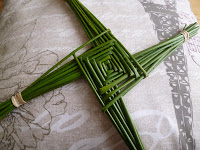A Cruz de Santa Brígida

 Next Saturday, February 1st, Ireland celebrates St. Brigid's Feast Day, the date of the Patron St. Brigid. Another Patron Saint in the country is St. Patrick.
Next Saturday, February 1st, Ireland celebrates St. Brigid's Feast Day, the date of the Patron St. Brigid. Another Patron Saint in the country is St. Patrick. She was born Faughart on county Louth in 453 and died on the year of 524. She was the first Irish noun and helped to found many convents. The most famous one was in Kildare, place where she died, reason why she is known by many as Saint Brigid of Kildare.
She was born Faughart on county Louth in 453 and died on the year of 524. She was the first Irish noun and helped to found many convents. The most famous one was in Kildare, place where she died, reason why she is known by many as Saint Brigid of Kildare.Santa Brígida é representada por uma curiosa cruz que leva o seu nome e que você vê em fotos neste post.
Diz a lenda que ela mesma teria feito essa cruz com junco para converter um homem que estava gravemente doente.
A partir dai a tradição foi sendo passada de boca em boca e até hoje é símbolo de proteção.
 She was recognized by her great kindness, and it is interesting she lived in the same time of St. Patrick, being much influenced religiously by him.
She was recognized by her great kindness, and it is interesting she lived in the same time of St. Patrick, being much influenced religiously by him.Saint Brigid is represented by a curious cross which takes her name and which you can see in picture on this post.
The legend says she made the cross herself with reed to convert a man that was seriously sick.
From there the tradition was passed orally and up to today it is a symbol of protection.
As pessoas colocam ainda hoje em seus lares para proteção também. Antigamente eram penduradas nos tetos contra incêndios.
As cruz de Santa Brígida é feita ainda hoje pela população que as vende na rua. No último sábado compramos a nossa cruz de uma irlandesinha linda que as vendia perto de casa.
 When we visited the Butter Museum here in Cork (read more about it here), we noticed in the old days the cow sheds had these crosses hanging on the walls for the protection of the cows and for them to produce a lot of milk.
When we visited the Butter Museum here in Cork (read more about it here), we noticed in the old days the cow sheds had these crosses hanging on the walls for the protection of the cows and for them to produce a lot of milk.People still today also hang it on their houses for protection. They used to be hanged on the ceilings against fires in the old days. Sat. Brigid's crosses are still today made by the same population who sell them on the streets. Last Saturday we got our cross from a pretty little Irish girl who was selling them near our home.
O nome Brígida deriva de uma Deusa Celta do fogo. Então por isso seria a protetora contra incêndios.
No dia 1 de fevereiro se festeja também o inicio da primavera no calendário celta.
 Tradition says the cross must protect the house until the 1st of February on the following year, when it needs to be burned.
Tradition says the cross must protect the house until the 1st of February on the following year, when it needs to be burned.The name Brigid comes from a Celtic Goddess of the fire. So this is why she would be the protector against fires.
On the first of February it is also celebrated the beginning of spring in the celtic calendar.


















Santa Brigida pray for us!
ResponderExcluirAdorei as informAçoes, onde será que acho a cruz no Brasil pra vender???
ResponderExcluirVc emcontra na Amora mine jardins em São Paulo, ele emvuam pelo correio.
ExcluirOI Mariana!
ResponderExcluirPuxa, não tenho nem ideia onde vende no Brasil Eu tentaria comprar em alguma loja on line Amazon, etc.